Comparative Analysis of the Performance and Study of the Effective Anchorage Length of Semi-Grouted and Fully-Grouted Sleeve Connection
Abstract
:1. Introduction
2. Experimental Investigation
2.1. Specimen Design
2.2. Material Properties
2.3. Test Device and Loading Method
3. Experimental Results and Discussion
3.1. Analysis of Damage Mode and Stress Mechanism
3.2. Analysis of the Influencing Factors of the Ultimate Bearing Capacity
3.3. Ultimate Bond Strength Model
- (1)
- Establishment of calculation formula based on fracture failure of steel bar outside joint:
- (2)
- Establishment of calculation formula based on bond failure between reinforcement and grout.
3.4. Effective Anchoring Length Model
4. Conclusions
- When the reinforcement diameter is the same and the anchorage length is sufficient, the performance of the semi-grouted joint is better than that of the fully-grouted joint.
- There is a critical anchorage length, that is, effective anchorage length, for both semi-grouted and full-grouted specimens. When the embedded length of the steel bar exceeds this limit, the bearing capacity of the joint no longer increases with the increase of the anchorage length. The critical anchorage length is the limit of two failure modes, namely, the fracture of steel bars and the withdrawal of steel bars.
- By comparing the two types of specimens, it can be found that when the steel bar diameter is the same, the performance of the semi-grout sleeve connection specimen is better than that of the full grout specimen, but the steel thread of the semi-grout specimen is prone to damage, and the quality should be strictly controlled during processing. In order to avoid the failure of the steel bar pulling out, the grouting quality should be controlled to ensure the corresponding anchorage length of the steel bar and the filling degree of grouting.
- Based on the mechanical principles and the test data, the reasonable value range of each parameter is determined by considering the diameter of reinforcement, anchorage length of reinforcement and grouting material performance, and the formulas for calculating ultimate bearing capacity, effective bond length model and maximum shear stress of semi-grouted and fully grouted joints are presented respectively. The formula presented in this paper is tested by tests and has also shown the bearing capacity increases with the reinforcement diameter and the effective anchorage length; the effective anchorage length increases with the reinforcement diameter and the yield strength of the reinforcement.
- In actual engineering, appropriate calculation formulas and parameters should be selected according to the specific situation to ensure the performance and safety of the connection joint.
Author Contributions
Funding
Data Availability Statement
Acknowledgments
Conflicts of Interest
Abbreviations
| s | the diameter of the rebar |
| B | half grouting connection |
| Q | full grouting connection |
| la | anchorage length of the reinforcement |
| Puk | the standard value of ultimate load |
| Pyk | the standard value of yield load |
| ultimate bearing capacity | |
| F0 | horizontal coordinate |
| fy | yield strength of the reinforcement |
| bond strength | |
| fm | strength of mortar |
| Le | effective anchoring length |
| K | plastic development coefficient of steel reinforcement |
| fu | ultimate tensile strength of the joint |
| K | grouting parameter |
| a,b | fitting coefficient of the bond strength |
| A | fitting coefficient of the anchorage length |
References
- Brunesi, E.; Peloso, S.; Pinho, R.; Nascimbene, R. Cyclic tensile testing of a three-way panel connection for precast wall-slab-wall structures. Struct. Concr. 2019, 20, 1307–1315. [Google Scholar] [CrossRef]
- Menegon, S.J.; Wilson, J.L.; Lam, N.T.K.; Gad, E.F. Experimental testing of innovative panel-to-panel connections for precast concrete building cores. Eng. Struct. 2020, 207, 110239. [Google Scholar] [CrossRef]
- Huang, Z.; Yang, Y.; Zhang, J.B.; Ma, S.; Cao, C. Experimental study on the tensile performance of a large-diameter UHPC grouted sleeve with thread. Eng. Struct. 2023, 294, 116707. [Google Scholar] [CrossRef]
- Ghayeb, H.H.; Razak, H.A.; Sulong, N.H.R. Performance of dowel beam-to-column connections for precast concrete systems under seismic loads: A review. Constr. Build. Mater. 2020, 237, 117582. [Google Scholar] [CrossRef]
- Cheng, J.F.; Luo, X.Y.; Cheng, Q.; Xing, M.L. Seismic performance of precast concrete walls with grouted sleeve connections using large-diameter bars. Soil Dyn. Earthq. Eng. 2023, 169, 107905. [Google Scholar] [CrossRef]
- Dabiri, H.; Kheyroddin, A.; Faramarzi, A. Predicting tensile strength of spliced and non-spliced steel bars using machine learning-and regression-based methods. Constr. Build. Mater. 2022, 325, 126835. [Google Scholar] [CrossRef]
- Shen, S.D.; Cui, Y.; Pan, P.; Gong, R.-H. Experimental study of RC prefabricated shear walls with shear keys affected by a slotted floor slab. J. Aerosp. Eng. 2019, 32, 04019013. [Google Scholar] [CrossRef]
- Nascimbene, R.; Bianco, L. Cyclic response of column to foundation connections of reinforced concrete precast structures. Numer. Exp. Comp. Eng. Struct. 2021, 247, 113214. [Google Scholar]
- Xu, J.K.; Guo, F.; Sha, J.F.; Xu, H.Y. Influence of grouting material on grouting connection performance of rebar sleeve. New Build. Mater. 2020, 47, 53–56+75. (In Chinese) [Google Scholar]
- Einea, A.; Yamane, T.; Tadros, M.K. Grout-filled pipe splices for precast concrete construction. PCI J. 1995, 40, 82–93. [Google Scholar] [CrossRef]
- Huang, Y.; Zhu, Z.G.; Naito, C.J.; Weijian, Y. Tensile behavior of half grouted sleeve connections: Experimental study and analytical modeling. Constr. Build. Mater. 2017, 152, 96–104. [Google Scholar]
- Wu, M.; Liu, H.T.; Du, X. Effect of tapered head sleeve structural parameters on grouting connection joints deformation. J. Mater. Civ. Eng. 2020, 32, 04020083. [Google Scholar] [CrossRef]
- Gao, Q.; Zhao, W.J. Experimental study on factors influencing the connection performance of grouted welded sleeves under uniaxial tensile loads. J. Build. Eng. 2021, 43, 103033. [Google Scholar] [CrossRef]
- Chen, J.W.; Wang, Z.W.; Liu, Z.Y.; Ju, S.L. Experimental investigation of mechanical properties of steel half-grouted sleeve splice with rebar bonding defects. J. Build. Eng. 2022, 50, 104113. [Google Scholar] [CrossRef]
- Xiao, J.Z.; Liu, L.L.; Li, J.X.; Zhou, X.M.; Kuang, Z.P.; Pan, Z.F. Reviewing and Analyzing of Performance of Grouted Sleeve Splice under Direct Tensile Load. Struct. Eng. 2020, 1, 1–9. (In Chinese) [Google Scholar]
- Alias, A.; Sapawi, F.; Kusbiantoro, A.; Zubir, M. Performance of grouted splice sleeve connector under tensile load. J. Mech. Eng. Sci. 2014, 7, 1094–1102. [Google Scholar] [CrossRef]
- Yu, Q.; Sun, J.Q.; Yuan, W.H. Experimental study on bond behavior between ribbed steel bars and sleeve constrained grouting material. J. Harbin Inst. Technol. 2018, 50, 98–106. (In Chinese) [Google Scholar]
- Yu, Q.; Xu, X.J.; You, G.S. Experimental study on bond behavior for ribbed steel bars and grout. J. Harbin Inst. Technol. 2017, 49, 91–101. (In Chinese) [Google Scholar]
- Qu, X.S.; Xie, Y.N.; Sun, Y.B.; Sun, G.J. Study of mechanical properties of grouting defective sleeve. Structures. 2023, 48, 1128–1140. [Google Scholar] [CrossRef]
- Gao, Q.; Zhao, W.J. Experimental study on performance of grouted sleeve connection with surfacing forming under uniaxial tensile load. J. Build. Struct. 2022, 43, 208–219. (In Chinese) [Google Scholar]
- Cao, D.; Pan, Z.F.; Zhang, Z.; Zeng, B. Experimental and numerical study on detection of sleeve grouting defect with impact-echo method. Structures 2023, 52, 632–650. [Google Scholar] [CrossRef]
- JGJ 355-2015; Technical Specification for Application of Reinforcement Sleeve Grouting Joints. Ministry of Housing and Urban-Rural Development: Beijing, China, 2016. (In Chinese)
- JGJ 107-2016; Technical Specification for Mechanical Joining of Reinforcement. Ministry of Housing and Urban-Rural Development: Beijing, China, 2016. (In Chinese)
- Acceptance Criteria for Mechanical Connector Systems for Steel Reinforcing Bars: AC-133; International Code Council: Whittier, CA, USA, 2010.
- Nassiraei, H. Probabilistic analysis of strength in retrofitted X-Joints under tensile loading and fire conditions. Buildings 2024, 14, 2105. [Google Scholar] [CrossRef]
- Liu, Q.Z.; Lin, Y.H.; Li, J.Z.; Yang, C.J.; Chen, J.Y.; Zhang, M.; Liu, B. Bond strength prediction model of defective grout materials in half-grouted sleeve connections under uniaxial and cyclic loadings. Constr. Build. Mater. 2022; 352, 128981. [Google Scholar]
- Chen, X.; Miao, Q.S.; Yang, C.T.; Ge, D.D.; Liu, Q.M.; Xie, L.L. Experimental study on tensile performance of defect detectable and repairable half grouted sleeve connection. Eng. Mech. 2020, 37, 199–207. [Google Scholar]
- Henin, E.; Morcous, G. Non-proprietary bar splice sleeve for precast concrete construction. Eng. Struct. 2015, 83, 154–162. [Google Scholar] [CrossRef]
- Rahman, A.B.A.; Yoon, L.H.; Ibrahim, I.S.; Mohamed, R.S.; Mohammad, S.; Saim, A.A. Performance of grouted splice sleeves with tapered bars under axial tension. Appl. Mech. Mater. 2015, 789–790, 1176–1180. [Google Scholar] [CrossRef]
- Zhou, W.X. Numerical Sulation of Tensile Behavior of Steel Sleeve Grouting Connection. South China J. Seismol. 2022, 42, 127–132. (In Chinese) [Google Scholar]
- Yin, F.F.; Yin, S.P.; Qin, T.H.; Wang, B.X.; Zhang, L.L.; Yang, N. Experimental study on the effect of grouting volume on the tensile performance of offset semi-grouted couplers. Constr. Build. Mater. 2022, 351, 128781. [Google Scholar] [CrossRef]
- Wang, Z.W.; Chen, J.W.; Ju, S.L.; Liu, Z.Y. Experimental study on the influence of loading mode and anchorage length on the connection performance of steel sleeve grouting. Ind. Archit. 2021, 51, 118–125+171. (In Chinese) [Google Scholar] [CrossRef]
- Zhao, J.; Yin, J.; Song, C. Liang, D.; Zhu, Y.H. Analysis of bonding properties of large diameter grouting sleeve considering grouting defects. Constr. Eng. 2021, 37, 106–112. (In Chinese) [Google Scholar] [CrossRef]
- GB 50010-2010; Code for Design of Concrete Structures. Ministry of Housing and Urban-Rural Development: Beijing, China, 2010. (In Chinese)
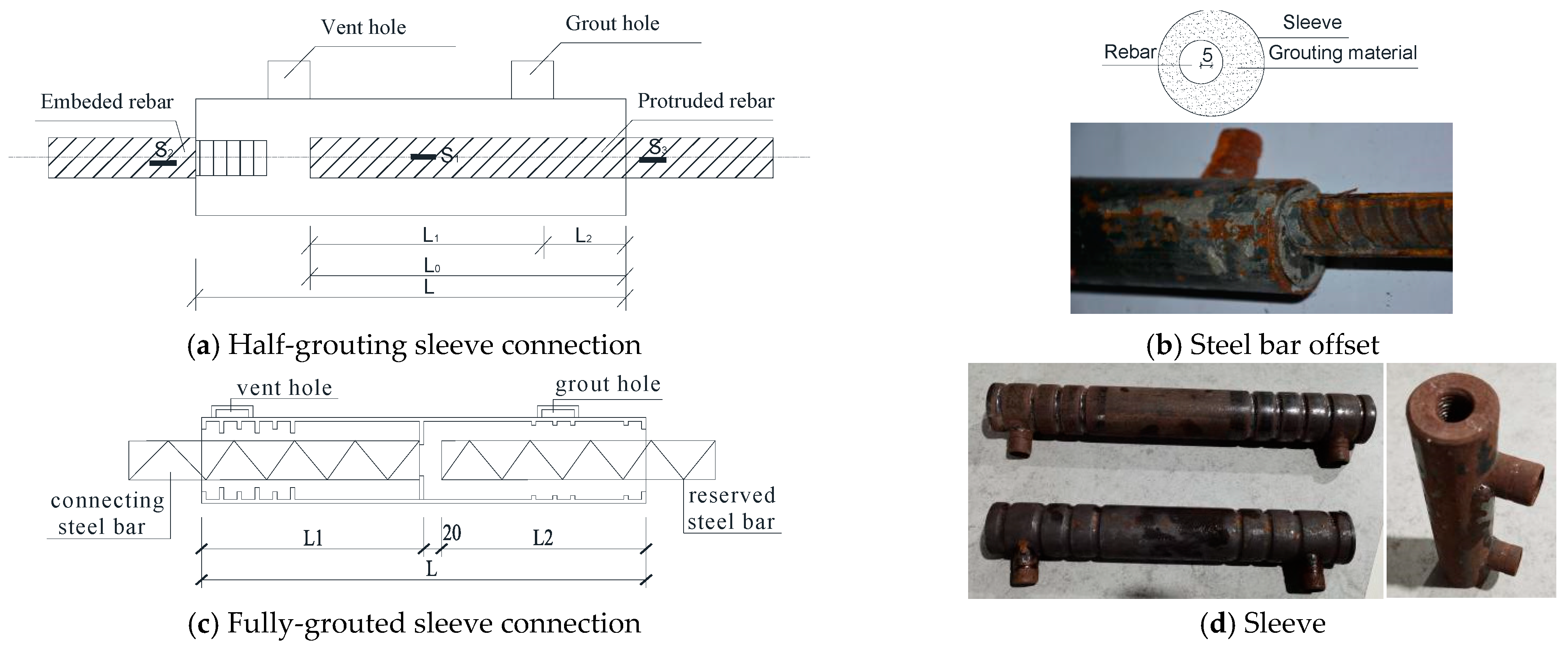


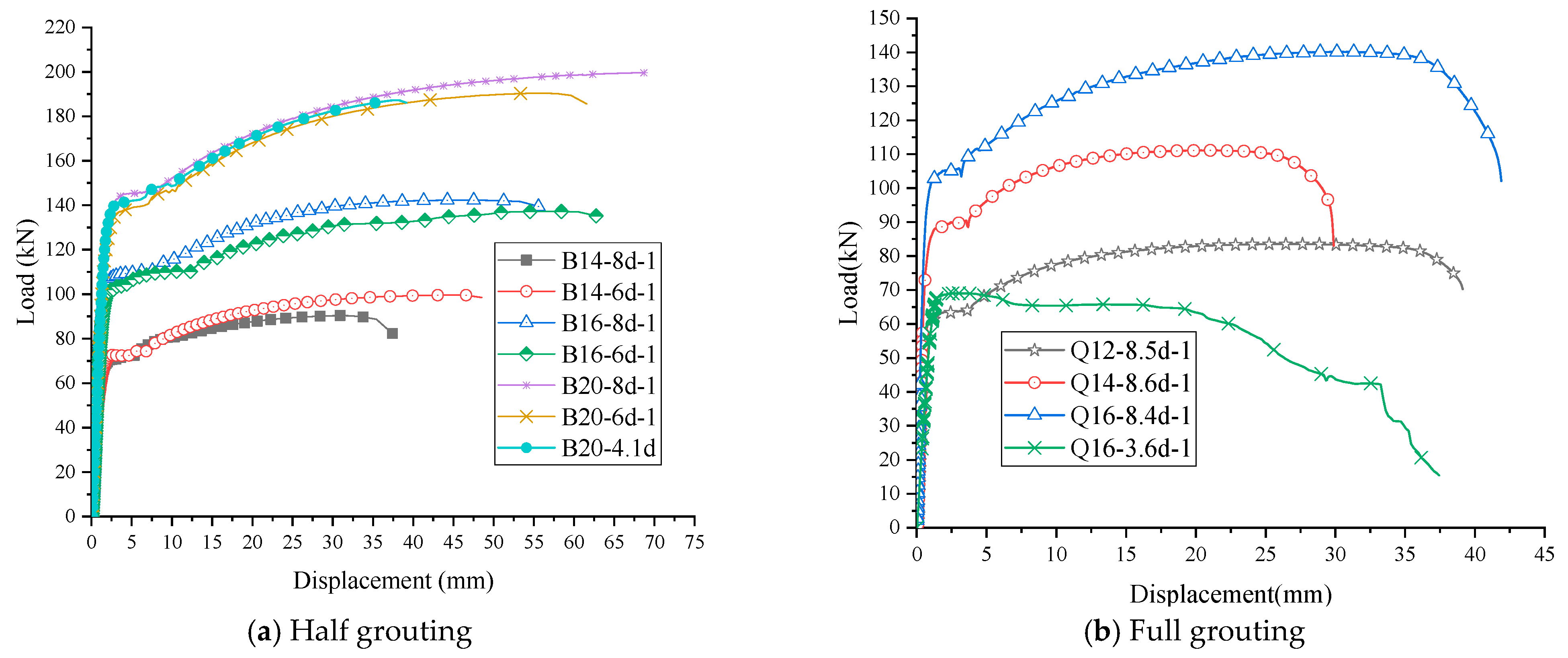
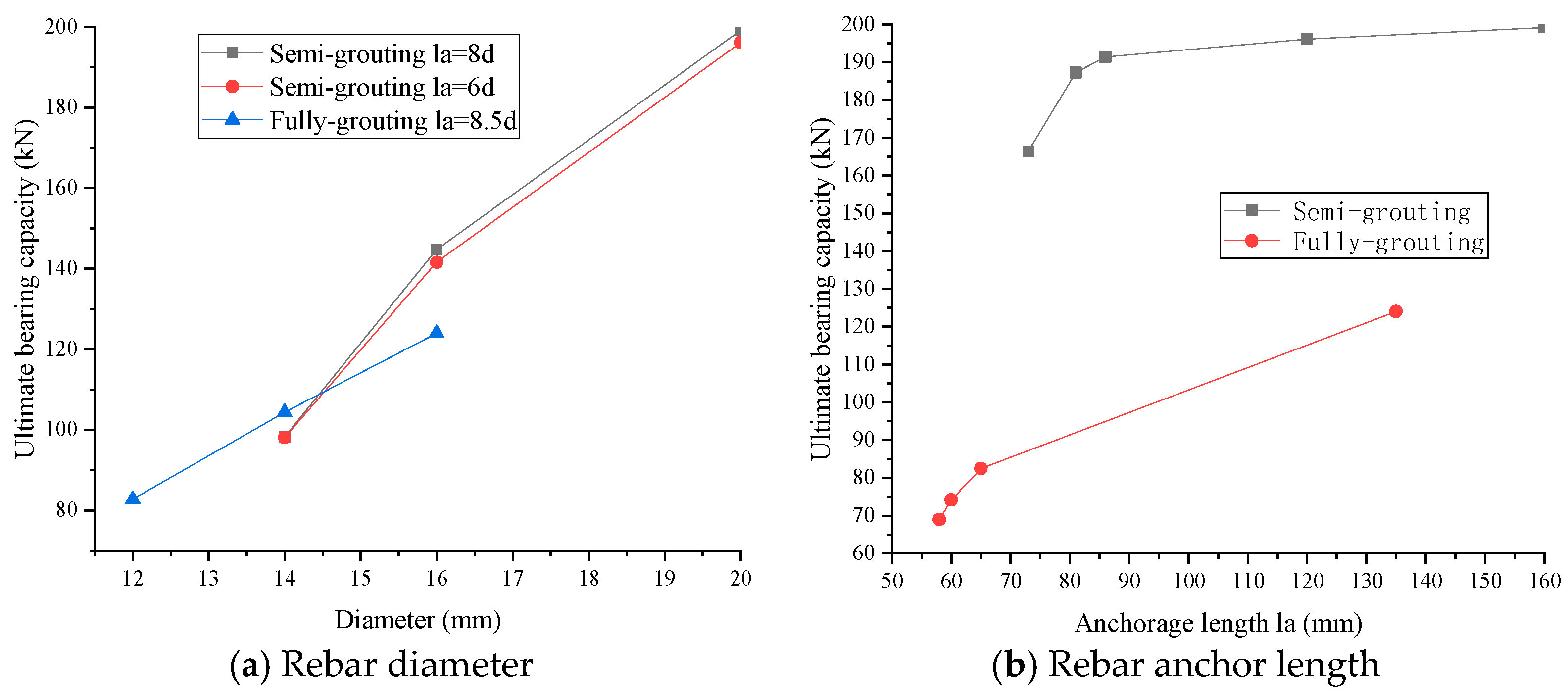

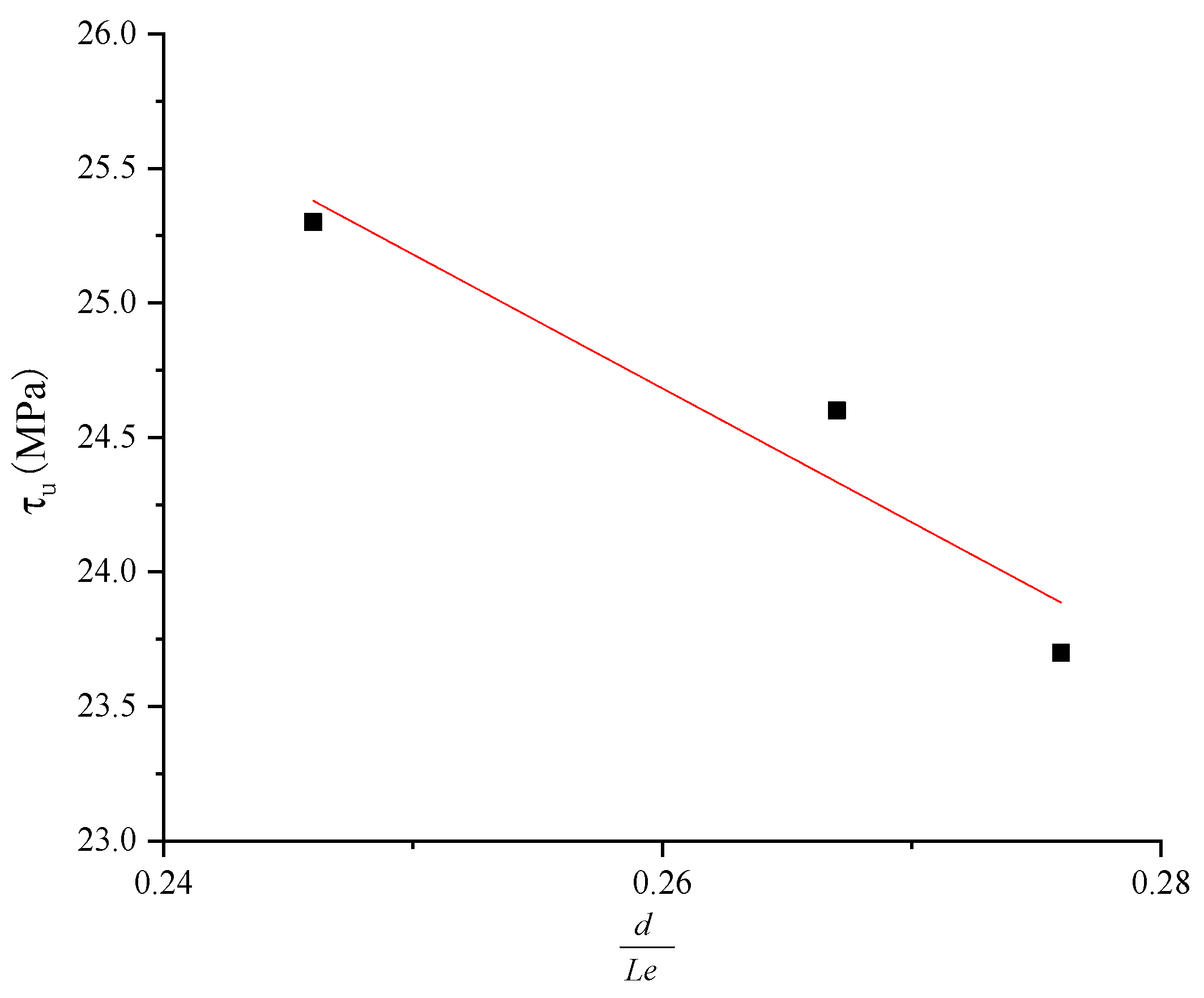
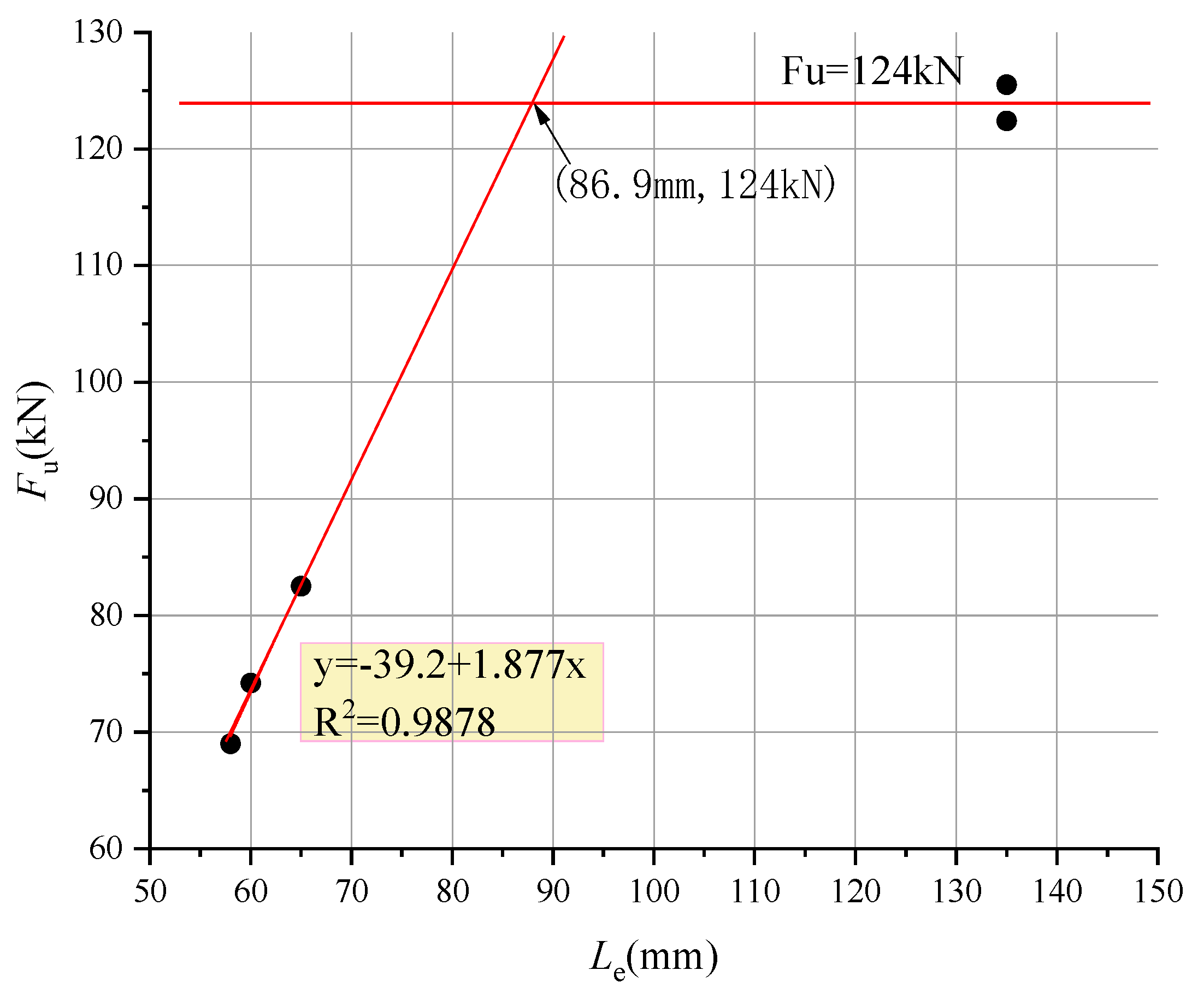
| Connection Form | Sleeve Model | Specimen Serial | Number | Measured Anchorage Length/mm | Fy/kN | Fu/kN | Puk;1.25 Pyk/kN | Damage Mode |
|---|---|---|---|---|---|---|---|---|
| semi-grouting | GT14 | B14-8d-1,2,3 | 3 | 112 (8d) | 78.5 | 98.3 | 61.6; 69.3 | Rebar fracture, yield |
| B14-6d-1,2,3 | 3 | 84 (6d) | 70.4 | 98.1 | Rebar fracture, yield | |||
| GT16 | B16-8d-1,2,3 | 3 | 128 (8d) | 109.6 | 144.7 | 80.4; 90.5 | Rebar fracture, yield | |
| B16-6d-1,2,3 | 3 | 96 (6d) | 109.4 | 141.6 | Rebar fracture, yield | |||
| GT20 | B20-8d-1,2,3 | 3 | 160 (8d) | 141.5 | 199.2 | 125.7;141.4 | Rebar fracture, yield | |
| B20-6d-1,2,3 | 3 | 120 (6d) | 140.8 | 196.1 | Rebar fracture, yield | |||
| B20-4.1d | 1 | 81 (4.1d) | 140.1 | 187.3 | Rebar pulled out, yield | |||
| B20-3.7d | 1 | 73 (3.7d) | 137.8 | 166.4 | Rebar pulled out, yield | |||
| B20-4.3d | 1 | 86 (4.3d) | 142.1 | 191.4 | Rebar pulled out, yield | |||
| full grouting | GTJQ4-12 | Q12-8.5d-1,2,3 | 3 | 102 (8.5d) | 60.2 | 82.8 | 45.2; 50.9 | Rebar fracture, yield |
| GTJQ4-14 | Q14-8.6d-1,2 | 3 | 120 (8.6d) | 76.7 | 104.4 | 61.6; 69.3 | Rebar fracture, yield | |
| GTJQ4-16 | Q16-8.4d-1,2 | 3 | 135 (8.4d) | 91.3 | 124 | 80.4; 90.5 | Rebar fracture, yield | |
| Q16-3.6d | 1 | 58 (3.6d) | - | 69.0 | Rebar pulled out, not yield | |||
| Q16-4.1d | 1 | 65 (4.1d) | - | 82.5 | Rebar pulled out, not yield | |||
| Q16-3.8d | 1 | 60 (3.8d) | - | 74.2 | Rebar pulled out, not yield |
| Connection Mode | Cited Literature | Specimen Serial | Rebar Diameter/mm | Fu/kN | F0/kN | Actual Calculated Value of K | Formula (1) F1 | |
|---|---|---|---|---|---|---|---|---|
| Semi-grouting | This paper | B14-8d-1,2,3 | 14 | 98.3 | 55.4 | 1.77 | 89.2 | −9.21% |
| B14-6d-1,2,3 | 14 | 98.1 | 55.4 | 1.77 | 89.2 | −9.02% | ||
| B16-8d-1,2,3 | 16 | 144.7 | 72.3 | 2.00 | 116.5 | −19.51% | ||
| B16-6d-1,2,3 | 16 | 141.6 | 72.3 | 1.96 | 116.5 | −17.74% | ||
| B20-8d-1,2,3 | 20 | 199.2 | 113 | 1.76 | 182.0 | −8.61% | ||
| B20-6d-1,2,3 | 20 | 196.1 | 113 | 1.74 | 182.0 | −7.17% | ||
| Q. Liu et al. [26] | C-0-4~9 | 22 | 250.3 | 136.8 | 1.83 | 220.4 | −11.95% | |
| X. Chen et al. [27] | F-d12-0 | 12 | 72.28 | 40.7 | 1.78 | 65.6 | −9.29% | |
| D-d12-15 | 12 | 70.86 | 40.7 | 1.74 | 65.6 | −7.47% | ||
| D-d12-30 | 12 | 70.94 | 40.7 | 1.74 | 65.6 | −7.57% | ||
| D-d20-0 | 20 | 203.27 | 113 | 1.80 | 182.0 | −10.44% | ||
| D-d20--15 | 20 | 198.31 | 113 | 1.75 | 182.0 | −8.20% | ||
| D-d20-30 | 20 | 196.13 | 113 | 1.74 | 182.0 | −7.18% | ||
| Fully-grouting | This paper | Q12-8.5d-1,2,3 | 12 | 82.8 | 40.7 | 2.03 | 63.7 | −23.02% |
| Q14-8.6d-1,2,3 | 14 | 95.6 | 55.4 | 1.73 | 86.8 | −9.25% | ||
| Q16-8.4d-1,2,3 | 16 | 124 | 72.3 | 1.72 | 113.2 | −8.69% | ||
| X. Qu et al. [19] | C-20 | 20 | 186 | 113 | 1.65 | 177.0 | −4.86% | |
| C-25 | 25 | 300 | 176.6 | 1.70 | 276.6 | −7.81% | ||
| Henin et al. [28] | 8T16 | 25.4 | 388.76 | 211.02 | 1.84 | 330.5 | −15.00% | |
| 8T18 | 389.64 | 211.02 | 1.85 | 330.5 | −15.19% | |||
| 8T18 | 387.87 | 211.02 | 1.84 | 330.5 | −14.80% | |||
| 8T18 | 390.09 | 211.02 | 1.85 | 330.5 | −15.29% | |||
| 8T18 | 389.20 | 211.02 | 1.84 | 330.5 | −15.09% | |||
| 8T20 | 389.64 | 211.02 | 1.85 | 330.5 | −15.19% | |||
| 8T20 | 378.08 | 211.02 | 1.79 | 330.5 | −12.60% | |||
| 9T20 | 28.65 | 463.93 | 272.92 | 1.70 | 427.4 | −7.88% | ||
| 9T20 | 463.48 | 272.92 | 1.70 | 427.4 | −7.79% | |||
| 9P20 | 435.46 | 272.92 | 1.60 | 427.4 | −1.85% |
| Connection Mode | Specimen Serial | Le/mm | Fu/kN | Formula (6) | Formula (7) | Relative Deviation |
|---|---|---|---|---|---|---|
| Fully-grouting | Q16-3.6d | 58 | 69.0 | 23.7 | 23.9 | 0.77% |
| Q16-4.1d | 65 | 82.5 | 25.3 | 25.3 | −1.20% | |
| Q16-3.8d | 60 | 74.2 | 24.6 | 24.3 | 0.30% |
| Specimen Serial | fy/kN | Fu/kN | Le/mm | Fracture State of Steel Bar Fu | Relative Deviation of Bearing Capacity | |
|---|---|---|---|---|---|---|
| Q12-8.5d | 532.3 | 82.8 | 78.8 | 29.8 | 85.8 | 3.57% |
| Q14-8.6d | 498.4 | 104.4 | 83.5 | 29.2 | 107.3 | 2.81% |
| Q16-8.4d | 454.0 | 124 | 89.6 | 28.4 | 124.1 | 0.11% |
Disclaimer/Publisher’s Note: The statements, opinions and data contained in all publications are solely those of the individual author(s) and contributor(s) and not of MDPI and/or the editor(s). MDPI and/or the editor(s) disclaim responsibility for any injury to people or property resulting from any ideas, methods, instructions or products referred to in the content. |
© 2024 by the authors. Licensee MDPI, Basel, Switzerland. This article is an open access article distributed under the terms and conditions of the Creative Commons Attribution (CC BY) license (https://creativecommons.org/licenses/by/4.0/).
Share and Cite
Yin, F.; Yin, S.; Zhang, L.; Xu, Y. Comparative Analysis of the Performance and Study of the Effective Anchorage Length of Semi-Grouted and Fully-Grouted Sleeve Connection. Buildings 2024, 14, 2977. https://doi.org/10.3390/buildings14092977
Yin F, Yin S, Zhang L, Xu Y. Comparative Analysis of the Performance and Study of the Effective Anchorage Length of Semi-Grouted and Fully-Grouted Sleeve Connection. Buildings. 2024; 14(9):2977. https://doi.org/10.3390/buildings14092977
Chicago/Turabian StyleYin, Fenfang, Shiping Yin, Linglei Zhang, and Yonggang Xu. 2024. "Comparative Analysis of the Performance and Study of the Effective Anchorage Length of Semi-Grouted and Fully-Grouted Sleeve Connection" Buildings 14, no. 9: 2977. https://doi.org/10.3390/buildings14092977






